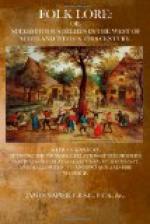“It’s no very decent
for you to be kissing,
It does not look weel wi’
the black coat ava,
’Twould hae set you
far better tae hae gi’en us your blessing,
Than thus by such tricks to
be breaking the law.
Dear Watty, quo Robin, it’s
just an auld custom,
And the thing that is common
should ne’er be ill taen,
For where ye are wrong, if
ye hadna a wished him
You should have been first.
It’s yoursel it’s to blame.”
The party now returned in the following order: first, the two fathers in company together, then the newly-married couple, behind them the best man and the best maid, and the others following in couples as they might arrange. There were frequently as many as twenty couples. On coming within a mile or so of the young couple’s house, where the mother of the young good man was waiting, a few of the young men would start on a race home. This race was often keenly contested, and was termed running the brooze or braize. The one who reached the house first and announced the happy completion of the wedding, was presented with a bottle of whiskey and a glass, with which he returned to meet the marriage procession, and the progress of the procession was generally so arranged that he would meet them before they arrived at the village or town where the young couple were to be resident. He was therefore considered their first foot, and distributed the contents of his bottle among the party, each drinking to the health of the young married




